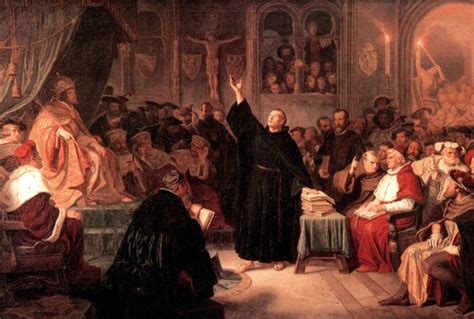Introduction
The Protestant Reformation was a major religious and political upheaval in Europe that began in the early 16th century. It led to the establishment of Protestantism, a new form of Christianity that broke away from the authority of the Catholic Church.

Key Figures
- Martin Luther (1483-1546): A German theologian and reformer who is considered the father of Protestantism. He challenged the Catholic Church’s authority and its doctrines, including the sale of indulgences.
- John Calvin (1509-1564): A French theologian and reformer who developed a system of theology known as Calvinism. His ideas influenced the development of Protestantism in Scotland, England, and the Netherlands.
- Henry VIII (1491-1547): King of England who broke with the Catholic Church and established the Church of England, a Protestant denomination.
- Diet of Worms (1521): A meeting of the Holy Roman Empire where Luther was summoned to defend his ideas. He refused to recant, leading to his excommunication from the Catholic Church.
Causes of the Reformation
- Religious Unrest: The Catholic Church’s authority was challenged by growing dissatisfaction with its practices, including the sale of indulgences and the corruption of the clergy.
- Humanism: The Renaissance’s emphasis on human reason and individual experience led to a questioning of traditional religious authority.
- Technological Advancements: The invention of the printing press allowed for the widespread distribution of religious ideas, contributing to the spread of Protestantism.
- Political Factors: Rulers such as Henry VIII sought to increase their power by breaking with the Catholic Church.
Key Ideas of Protestantism
- Sola Scriptura: The belief that the Bible is the sole authority for Christian doctrine.
- Sola Fide: The belief that salvation is achieved through faith alone, not through good works.
- Sola Gratia: The belief that salvation is a gift of God’s grace and cannot be earned through human effort.
- The Priesthood of All Believers: The belief that all Christians have direct access to God without the need for priests or other mediators.
Impact of the Reformation
- Religious Division: The Reformation led to the division of Europe into Protestant and Catholic areas, resulting in religious wars and political conflicts.
- Challenge to Authority: The Reformation weakened the authority of the Catholic Church and challenged the traditional hierarchical system of society.
- Spread of Protestantism: Protestantism spread rapidly throughout Europe, especially in northern Germany, England, and the Netherlands.
- Cultural and Social Change: The Reformation influenced art, music, literature, and education, leading to the development of new forms of expression and social practices.
Spread of Protestantism
Table 1: Spread of Protestantism in Europe
| Region | Number of Protestants (1600) |
|---|---|
| Germany | 20 million |
| England | 5 million |
| Netherlands | 3 million |
| France | 2 million |
| Switzerland | 1 million |
How Protestantism Changed Education
- Emphasis on Literacy: Protestants believed that individuals should be able to read the Bible for themselves, leading to increased literacy rates.
- Establishment of Protestant Universities: Protestants founded universities such as Wittenberg University in Germany and Cambridge University in England, which became centers of learning and scholarship.
- Curriculum Reform: Protestant universities incorporated humanist ideas and emphasized classical languages, science, and mathematics.
Benefits and Challenges of Protestantism
Benefits
- Religious Freedom: Protestantism allowed individuals to choose their own religious beliefs and practices.
- Education: Protestantism promoted literacy and the establishment of schools and universities.
- Economic Growth: Protestantism encouraged thrift and hard work, which contributed to economic growth in Protestant regions.
Challenges
- Religious Wars: The Protestant Reformation led to decades of religious wars in Europe, resulting in significant loss of life and destruction.
- Social Division: Protestantism created social divisions between Protestants and Catholics, leading to discrimination and persecution.
- Political Instability: The Reformation weakened the authority of the monarchs and challenged traditional social hierarchies, contributing to political instability in some regions.
Conclusion
The Protestant Reformation was a transformative event in European history that permanently altered the religious landscape and social and political structures of the continent. Protestantism’s emphasis on individual faith, the authority of Scripture, and the priesthood of all believers continues to shape Christianity today.
